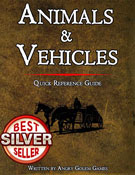Large beast (animal), unaligned
Armor Class 11
Hit Points 19 (3d10+3)
Speed 50 ft.
Proficiency Bonus +2
Proficiency Bonus +3 (5th Edition Advanced Mode)
| STR | DEX | CON | INT | WIS | CHA |
|---|---|---|---|---|---|
| 14 (+2) | 12 (+1) | 12 (+1) | 2 (-4) | 10 (+0) | 5 (-3) |
Skills (suggested) Perception +2
Senses passive Perception 10
Challenge 1/4 (50 XP)
Sudden Charge (suggested). If the axe beak runs at least 20 feet as part of its movement, it can then use this action to charge one target. The target must succeed on a DC 12 Dexterity saving throw or be knocked prone. The axe beak can then make a beak attack as a bonus action on the target. On a successful save, the creature takes no damage, isn’t knocked prone, and is pushed 5 feet out of the axe beak’s space into an unoccupied space. If no unoccupied space is within range, the creature instead falls prone.
ACTIONS
- Beak. Melee Weapon Attack: +4 to hit, reach 5 ft., one target. Hit: 6 (1d8 + 2) slashing damage.
- Beak (suggested). Melee Weapon Attack: +4 to hit, reach 10 ft., one target. Hit: 6 (1d8 + 2) slashing damage.
DESCRIPTION
An axe beak is a large and ferocious flightless bird that resembles a cross between an ostrich and a vulture. It has a long neck, powerful legs, and a sharp wedge-shaped beak that can slice through flesh and bone. Its feathers are usually brown or black, with patches of white or gray on its head and chest. Its eyes are yellow and piercing, and its voice is a loud screech that can be heard from miles away.
COMBAT
An axe beak is not a timid creature. It has a nasty disposition and tends to attack any unfamiliar creature that wanders too close to its territory. It can run faster than most horses, and uses its speed and agility to charge at its enemies and strike with its beak. An axe beak’s beak can deal slashing damage to one target, and can also be used to grab and shake smaller prey. An axe beak is loyal to its rider, but can be difficult to train and control. It requires constant attention and care, and will not hesitate to bite or kick anyone who mistreats it.
HABITAT / SOCIETY
An axe beak is native to the grasslands and hills, where it roams in flocks of up to a dozen individuals. An axe beak flock is led by the largest and strongest member, who decides where to hunt and nest. An axe beak flock will defend its territory from intruders, but will also migrate to follow the seasons and the food supply. An axe beak can also adapt to other environments, such as forests, mountains, or deserts, as long as there is enough space and prey for it.
An axe beak is often used as a mount by nomadic tribes of bugbear and human barbarians. These tribes value the axe beak’s speed, strength, and ferocity, and use them to raid and plunder other settlements. An axe beak rider forms a bond with his or her mount, and treats it with respect and affection. An axe beak rider can communicate with his or her mount through simple commands and gestures, and can also sense its emotions and intentions.
ECOLOGY
An axe beak is a carnivorous creature that feeds on small animals, such as rodents, rabbits, birds, or lizards. It can also hunt larger prey, such as deer, antelope, or even humans, if it is hungry enough. An axe beak can consume up to 10% of its body weight in one meal, and can go for several days without eating. An axe beak has few natural predators, except for dragons, griffons, or other large flying creatures that can catch it off guard.
An axe beak reproduces by laying eggs in a shallow nest made of grass and feathers. An axe beak lays one or two eggs at a time, which hatch after two months of incubation. The hatchlings are covered in downy feathers, and can walk and run within hours of hatching. The hatchlings stay with their parents for about a year, until they are fully grown and ready to join or form their own flocks.
The statistics are detailed in the D&D 5e Animals & Vehicles reference guide.
Just have a look at the preview on DrivethruRpg.
